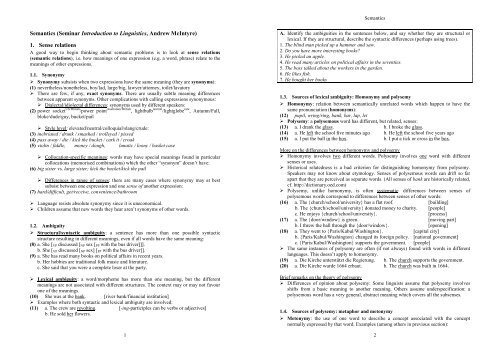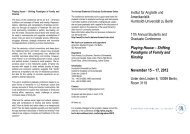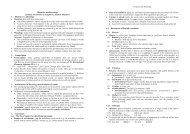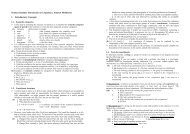Semantics (Seminar Introduction to Linguistics, Andrew McIntyre) 1 ...
Semantics (Seminar Introduction to Linguistics, Andrew McIntyre) 1 ...
Semantics (Seminar Introduction to Linguistics, Andrew McIntyre) 1 ...
- No tags were found...
Create successful ePaper yourself
Turn your PDF publications into a flip-book with our unique Google optimized e-Paper software.
<strong>Semantics</strong><strong>Semantics</strong> (<strong>Seminar</strong> <strong>Introduction</strong> <strong>to</strong> <strong>Linguistics</strong>, <strong>Andrew</strong> <strong>McIntyre</strong>)1. Sense relationsA good way <strong>to</strong> begin thinking about semantic problems is <strong>to</strong> look at sense relations(semantic relations), i.e. how meanings of one expression (e.g. a word, phrase) relate <strong>to</strong> themeanings of other expressions.1.1. Synonymy Synonymy subsists when two expressions have the same meaning (they are synonyms):(1) nevertheless/nonetheless, boy/lad, large/big, lawyer/at<strong>to</strong>rney, <strong>to</strong>ilet/lava<strong>to</strong>ry There are few, if any, exact synonyms. There are usually subtle meaning differencesbetween apparent synonyms. Other complications with calling expressions synonymous: Dialectal/idiolectal differences: synonyms used by different speakers:(2) power socket US/British /power point Australian/British , lightbulb normal /lightglobe rare , Autumn/Fall,bloke/dude/guy, bucket/pail Style level: elevated/neutral/colloquial/slang/crude:(3) inebriated / drunk / smashed / trolleyed / pissed(4) pass away / die / kick the bucket / cark it / croak(5) violin / fiddle, money / dough, lunatic / loony / basket case Collocation-specific meanings: words may have special meanings found in particularcollocations (memorised combinations) which the other “synonym” doesn’t have:(6) big sister vs. large sister; kick the bucket/kick the pail Differences in range of senses: there are many cases where synonymy may at bestsubsist between one expression and one sense of another expression:(7) hard/difficult, get/receive, convenience/bathroom Language resists absolute synonymy since it is uneconomical. Children assume that new words they hear aren’t synonyms of other words.1.2. Ambiguity Structural/syntactic ambiguity: a sentence has more than one possible syntacticstructure resulting in different meanings, even if all words have the same meaning:(8) a. She [ VP discussed [ NP sex [ PP with the bus driver]]].b. She [ VP discussed [ NP sex] [ PP with the bus driver]].(9) a. She has read many books on political affairs in recent years.b. Her hobbies are traditional folk music and literature.c. She said that you were a complete loser at the party. Lexical ambiguity: a word/morpheme has more than one meaning, but the differentmeanings are not associated with different structures. The context may or may not favourone of the meanings.(10) She was at the bank. [river bank/financial institution] Examples where both syntactic and lexical ambiguity are involved:(11) a. The crew are revolting. [-ing-participles can be verbs or adjectives]b. He sold her flowers.1A. Identify the ambiguities in the sentences below, and say whether they are structural orlexical. If they are structural, describe the syntactic differences (perhaps using trees).1. The blind man picked up a hammer and saw.2. Do you have more interesting books?3. He picked an apple.4. He read many articles on political affairs in the seventies.5. The boss talked about the workers in the garden.6. He likes fish.7. He bought her books1.3. Sources of lexical ambiguity: Homonymy and polysemy Homonymy: relation between semantically unrelated words which happen <strong>to</strong> have thesame pronunciation (homonyms):(12) pupil, wring/ring, bank, bar, lap, let Polysemy: a polysemous word has different, but related, senses:(13) a. I drank the glass. b. I broke the glass.(14) a. He left the school five minutes ago b. He left the school five years ago(15) a. I put the ball in the box. b. I put a tick or cross in the box.More on the differences between homonymy and polysemy Homonymy involves two different words. Polysemy involves one word with differentsenses or uses. His<strong>to</strong>rical relatedness is a bad criterion for distinguishing homonymy from polysemy.Speakers may not know about etymology. Senses of polysemous words can drift so farapart that they are perceived as separate words. (All senses of bank are his<strong>to</strong>rically related,cf. http://dictionary.oed.com) Polysemy, unlike homonymy, is often systematic: differences between senses ofpolysemous words correspond <strong>to</strong> differences between senses of other words:(16) a. The {church/school/university} has a flat roof. [building]b. The {church/school/university} donated money <strong>to</strong> charity. [people]c. He enjoys {church/school/university}. [process](17) a. The {door/window} is green. [moving part]b. I threw the ball through the {door/window}. [opening](18) a. They went <strong>to</strong> {Paris/Kabul/Washing<strong>to</strong>n}. [capital city]b. {Paris/Kabul/Washing<strong>to</strong>n} changed its foreign policy. [national government]c. {Paris/Kabul/Washing<strong>to</strong>n} supports the government. [people] The same instances of polysemy are often (if not always) found with words in differentlanguages. This doesn’t apply <strong>to</strong> homonymy.(19) a. Die Kirche unterstützt die Regierung. b. The church supports the government.(20) a. Die Kirche wurde 1664 erbaut. b. The church was built in 1664.Brief remarks on the theory of polysemy Differences of opinion about polysemy: Some linguists assume that polysemy involvesshifts from a basic meaning <strong>to</strong> another meaning. Others assume underspecification: apolysemous word has a very general, abstract meaning which covers all the subsenses.1.4. Sources of polysemy: metaphor and me<strong>to</strong>nymy Me<strong>to</strong>nymy: the use of one word <strong>to</strong> describe a concept associated with the conceptnormally expressed by that word. Examples (among others in previous section):2
<strong>Semantics</strong>(21) a. The pianist was playing Beethoven (=a work by Beethoven)b. The chair is under the table (chair = seat of chair; table = table<strong>to</strong>p)c. They counted the heads at the meeting (heads = people) Metaphor: the use of the the term for one concept X <strong>to</strong> refer <strong>to</strong> another concept Y, whereX and Y have properties in common.(22) a. That guy is a pansy/fridge/machine/tiger.b. The newspaper report exploded the myths about Egbert Jones’ private life.c. She said <strong>to</strong> her ex-boyfriend ‘You’ve chewed on my heart and spat it out again.’d. He’s got nerves of steel and a heart of s<strong>to</strong>ne.e. The preacher said that heavy metal music rips your mind and soul <strong>to</strong> pieces. Compare metaphors <strong>to</strong> similes (structures like (23) were the italicised elements expressexplicitly that a comparison is being made). Metaphors are essentially similes withoutthese explicit comparison expressions.(23) a. His mind is like a computer. [deleting like yields a metaphor]b. That guy at the door is built like a fridge.c. The way Bill criticised John resembled beating him over the head with a stick.d. Talking <strong>to</strong> Bill is like trying <strong>to</strong> knit a sweater with only one needle. If metaphoric expressions are interpreted literally, they often yield impossibleinterpretations: John has a screw loose doesn’t make sense literally, so we are forced <strong>to</strong>interpret it metaphorically. Metaphors are often thought of as a literary/rhe<strong>to</strong>rical device, but they are also common ineveryday language, even in cases of so-called dead metaphors which are not consciouslyperceived as metaphorical (e.g. go in<strong>to</strong> a subject; expert in a field). Some linguists (e.g. Cognitive Grammarians) define metaphor as a pattern of thoughtrather than something purely linguistic. In this definition, a metaphoric expression is notitself a metaphor but a realisation of a metaphor. Examples (metaphors in capitals):(24) TIME IS MONEY: spend/save/invest time; my time ran out(25) THE MIND IS A COMPUTER: My mind is on the blink/malfunctioned/needs more input(26) LIFE IS A JOURNEY: my life is going nowhere; this is a dead-end job; I’m at acrossroads in my life; my life is headed in the wrong direction; I chose a difficult pathfor my life(27) STATES ARE LOCATIONS: I flew in<strong>to</strong> a rage; He is in a sad state; I went in<strong>to</strong> adepression; it went from bad <strong>to</strong> worse; how can we get him out of this self-pity?(28) GOOD STATES ARE UP: this brings me down; high spirits; this raised my spirits(29) VIRTUE IS UP: high-minded, a low trick, uplifting thoughts, s<strong>to</strong>op <strong>to</strong> illegal activities(30) TIME IS SPACE: It was at/around/<strong>to</strong>wards/near three o’clock; Christmas wasapproaching/far off/near; the day came when…; Note that some such metaphoric schemata subsume others.1.5. An<strong>to</strong>nymy An<strong>to</strong>nymy (relations of opposition or contrast): Binary (non-gradable) an<strong>to</strong>nymy: Negation of one of a pair of an<strong>to</strong>nyms entails theother an<strong>to</strong>nym. These are either-or decisions with no middle ground.(31) dead/alive, possible/impossible, female/male, odd/even (numbers), hit/miss (targets) Gradable an<strong>to</strong>nymy: an<strong>to</strong>nyms at opposite ends of a scale with varying degreespossible.(32) a. rich/poor, young/old, fast/slow, near/farb. hot/warm/tepid/cool/cold Tests for gradability:(33) a. COMPARATIVE: Mary is {more intelligent/more feminine/*more female} than John3b. DEGREE MODIFIERS: Mary is very {intelligent/*dead}Mary {hated/admired/*hit/*electrocuted} John very much These terms are often relative: a long pencil might be shorter than a short ruler and anintelligent animal could be less intelligent than a stupid person. Also intermediate terms:. Note on markedness: sometimes one member of a pair/scale of an<strong>to</strong>nyms is unmarked inthe sense that it can stand for a the whole scale:(34) a. John is 1 metre {tall/*short}. b. How {long/*short} is the rope?c. The baby is 1 week {old/*young} Standards with gradable adjectives are relative, cf. (35). The degree of the property isjudged according <strong>to</strong> the norm for the type of entity modified by the adjective (itscomparison class). (36) illustrates expressions mentioning comparison classes explicitly.(35) A small horse is larger than a large dog.(36) a. He’s young for a president.b. He’s healthy as drug addicts go.c. She’s well-read considering that she’s eight years old.d. He’s illiterate compared <strong>to</strong> other lawyers.1.6. Meronymy Meronymy part-whole relations:(37) a. body>arm>hand>finger b. bike>wheel>tyre>valve In many languages, certain expressions treat parts in the same way as possessions. Therelation between possessor and possession is called alienable possession (possessor canchoose <strong>to</strong> get rid of possession), while the relation between part and whole is an instanceof inalienable possession (possessor can’t (easily) get rid of the possession).(38) ALIENABLE: Mary has a car; Mary’s car; people with cars(39) INALIENABLE: Mary has red hair; Mary’s red hair; people with red hair1.7. Hyponymy and taxonomies Hyponymy: relationship of the type “x is a more specific instance of y”. Examples/terms: dog is a hyponym of animal animal is a hyperonym (also: hypernym, superordinate term) of dog dog, cat are cohyponyms (taxonomic sisters) Taxonomy: classification of concepts in hyponymic or co-hyponymic relations:(40) furniturechair table ....desk chair armchair .... coffee table dining table ... Taxonomies may differ between cultures/languages/individuals. Language reflects folktaxonomies (non-scientific classifications which needn’t correspond with reality). In many taxonomies one can identify three levels: superordinate/basic level/subordinate.Basic level: highest classification allowing common visual representation. Most frequentlevel of generality used in naming objects (Look! There’s an {elephant/*animal/*Africanelephant}. Basic level terms are the first ones learnt by children and are usually shorterwords than their hyponyms (e.g. not compounds). Au<strong>to</strong>hyponym: a term with two meanings, one of which is the hypernym of the other.E.g. waiter (hyperonym for waiter/waitress); cow (hyperonym for cow/bull); hoover.4
<strong>Semantics</strong>B. Name the lexical relations relevant in the following cases. (Be as specific as possible, e.g.‘binary an<strong>to</strong>nomy’ rather than just ‘an<strong>to</strong>nymy’.1. bike/vehicle 2. Monday/Tuesday 3. despite/ in spite of4. wise/stupid 5. occupied/vacant 6. nevertheless/nonetheless7. like/hate 8. lead/led2. On the nature of meaning2.1. Sense and reference, and similar distinctions The reference of an expression is either (a) what it refers <strong>to</strong> in the real world or (b) theability of the expression <strong>to</strong> refer <strong>to</strong> something in the real world. (The two senses arerelated by me<strong>to</strong>nymy.) For our purposes denotation is a synonym of reference. The sense of the expression is its meaning minus its reference, i.e. the properties that theexpression has which (a) distinguish that expression from other expressions and (b) helpdetermine what it might have reference <strong>to</strong>.(41) The morning star is the evening star. [both have same reference (=Venus), but havedifferent sense (morning vs. evening visibility)](42) Kevin Rudd became Australian Prime Minister on 3.12.2007. Therefore:a. Kevin Rudd [Sense: none, because proper names don’t have sense;Reference: a particular politician in the Australian Labor party, born in 1957...]b. the current Prime Minister of Australia [Reference: currently the same as that ofKevin Rudd; Sense: a property of a person who is the Australian head of state](43) the present King of France [Reference: none](44) an elephant [Reference: any elephant; Sense: properties include (a) having a trunk,(b) being grey, (c) being an animal originally from Africa or Asia, (d) being large...] A related dicho<strong>to</strong>my: intension: the set of all properties that constitute the sense of anexpression; extension: all things that ever (will) have existed <strong>to</strong> which an expression canrefer. Roughly, intension=sense and extension=reference. Constant vs. variable reference: Proper names have constant reference: Julius Caesar,Greece, the Pacific Ocean, the Eiffel <strong>to</strong>wer. Variable reference subsists with other NPs,which may change their reference (cf. she, a car, the President of the USA). Contrast denotation with connotation, subjective, emotional aspects of meaningconsidered less central <strong>to</strong> definition than denotation/reference is.2.2. Types, <strong>to</strong>kens and related notions Types vs. <strong>to</strong>kens: a <strong>to</strong>ken is a specific instance of a type of thing.(45) a. This car shop has only sold three cars. [possibly “3 types of cars”; e.g. 17Mercedes, 18 VWs and 9 Porsches]b. He wears the same t-shirt every dayc. Ralph is standing there with an empty glass again. (though it was full a minuteago/even though I have seen him order at least four beers from the bar)d. I want <strong>to</strong> read an introduction <strong>to</strong> physics (but I can't find it/one).5e. He went <strong>to</strong> the pub on Friday nights.(46) a. Tigers are dangerous animals. [type]b. The tiger is a dangerous animal. [type (=tigers) or <strong>to</strong>ken (=that tiger)] If an expression refers <strong>to</strong> a type, it has a generic or non-specific reading. Some linguistssee non-specific/generic readings of an expression as non-referential (as lackingreference), whereas others would describe them as referring <strong>to</strong> types or kinds. Reference <strong>to</strong> types often involves lack of an article:(47) a. They go <strong>to</strong> church on Sundays.b. He was elected president/leaderc. Er ist Arzt. Shift from mass noun <strong>to</strong> count noun, hence different article in referring <strong>to</strong> a type:(48) a. Gruyère is a cheese. b. This is a good beer. The type/<strong>to</strong>ken distinction also applies <strong>to</strong> situations expressed by VPs/sentences,depending on whether a specific situation or a generic or habitual one is expressed. Thisdistinction is influenced by the context, and can influence the specificity of NPs.(49) a. Someone listened <strong>to</strong> a cd in the kitchen yesterday. [specific listening event]b. Someone listened <strong>to</strong> a cd in the kitchen every night. [specific listening events]c. If people listen <strong>to</strong> a cd in the kitchen... [non-specific event] Non-specific (generic/habitual) readings of events allow the simple present in English,otherwise we normally use the progressive (except with states).(50) a. I listen <strong>to</strong> a cd every day. [but I am not listening <strong>to</strong> one now]b. People read their e-mail with a computer.2.3. Two approaches <strong>to</strong> reference Mentalist approach: reference is not <strong>to</strong> objects in the real word, but <strong>to</strong> concepts orobjects in a mentally projected word. Arguments: we can talk about things which do notexist in the real world. Real-world approach: reference is <strong>to</strong> things in the real world. One argument for thisapproach is that a representational approach, in saying e.g. that house refers <strong>to</strong> the mentalrepresentation or concept HOUSE, merely delegates the problem of meaning <strong>to</strong>psychologists and makes use of psychological constructs about which we know little.3. Scope• Scope: the portion of the sentence <strong>to</strong> which the meaning of an expression applies, withwhich it interacts and whose interpretation it can influence.Example 1: a scope ambiguity with English adjectives:(51) Grandma likes French literature and industrial grunge music. [French has scope overliterature or over literature and industrial grunge music]Example 2: The scope of modal verbs and negation:(52) a. Du sollst das machen. ≈ It is necessary that you do that.b. Du musst das machen. “c. You need <strong>to</strong> do that. “d. You must do that. “(53) The modal expression has scope over negation:a. Du sollst das nicht machen. ≈ It is necessary that you do not do that.6
<strong>Semantics</strong>b. You must not do that. “(54) Negation has scope over the modal expression:a. Du musst das nicht machen. ≈ It’s not necessary that you do that.b. You do not need <strong>to</strong> do that. “Other examples:(55) Bruce's father <strong>to</strong>ld him <strong>to</strong> mow the lawn and <strong>to</strong> water the plants often.(56) Elvis only copied the literature for the seminar.4. Decomposition Decomposition: division of meanings of morphemes/words in<strong>to</strong> smaller units of meaning.4.1. Example 1: Componential analysis Componential analysis divides meanings of words in<strong>to</strong> components with binary values.The components are meant <strong>to</strong> be primitive (= not further decomposable).(57) woman [+human] [+feminine] [+adult](58) man [+human] [-feminine] [+adult](59) girl [+human] [+feminine] [-adult](60) child [+human] [-adult]• Componential analysis of this type is useful for handling cases where many pairs of wordsdiffer with respect <strong>to</strong> a single feature:(61) a. [+feminine] vs. [-feminine]: girl/boy, woman/man, cow/bull...b. [-adult] vs. [+/-adult]: puppy/dog, kitten/cat, piglet/pig, foal/horse...• Why a binary feature analysis doesn’t apply <strong>to</strong> all words:(62) a. This {boy/teenager/ * child} is 17 years old. → [-adult] isn’t precise enoughb. January → [+january] [-february] [-march]...???c. duck → [+quack]...d. swan, canary, emu, elephant → [-quack]...???C. How could one express the differences between the following words using componentialanalysis?horse foal stallion mare4.2. Example 2: Causative verbs of change of state• Causative verbs of change of state: the subject does something which causes the object <strong>to</strong>enter a state indicated by the meaning of the verb. Inchoative verbs: the subject enters thestate indicated by the verb. Put otherwise, the state indicated by the verb begins <strong>to</strong> exist(inchoative
<strong>Semantics</strong>words (say compounds) or syntactic constituents (say NPs, sentences) is derived from themeanings of the individual meaningful elements.D. The underlined expressions have idiomatic interpretations which do not (completely)obey the Principle of Compositionality. What is meant by this?1. Gertrude let the cat out of the bag 2. Francine kicked the bucket3. Egbert is round the bend 4. Edeltraud hat ihn auf die Palme gebracht6. Semantic roles vs. grammatical relations Thematic roles (also called semantic roles, theta roles, θ roles): descriptions of thesemantic relation between a predicate and its argument(s). Grammatical relations: (also called grammatical functions) descriptions of the syntacticposition of an argument.The most important thematic rolesAGENT: initia<strong>to</strong>r/causer of an eventPATIENT: entity affected/changed by the event:(1) Fred AGENT painted the wall PATIENT .RECIPIENT Person receiving something:(2) Wayne gave his grandmother RECIPIENT an industrial grunge cd.BENEFICIARY Person who benefits from the event:(3) I made a cup of coffee for the guests BENEFICIARY .THEME: entity whose position/direction is indicated (also used by some linguists for patientsand as a cover term for cases whose thematic role is not clearly definable):(4) The ball THEME rolled down the hill; Fred THEME is in the kitchenEXPERIENCER: entity which experiences an emotion or other psychological/mental state. Theentity triggering this response is called a theme or stimulus:(5) Basil EXPERIENCER likes the music THEME .INSTRUMENT: thing used <strong>to</strong> perform an action:(6) I wiped the table with a rag INSTRUMENT .GOAL/SOURCE: start/endpoint of a motion event:(7) She went from Paris SOURCE <strong>to</strong> London GOAL .LOCATION: place where an entity/event is/occurs:(8) She worked in the office LOCATION An important area of grammatical research (which we lack the time <strong>to</strong> discuss) is <strong>to</strong>determine how an NP with a particular thematic role is realised using a particulargrammatical relation. One point which can be made here is that (in languages likeEnglish) every sentence has a subject. This means that sentences with only one NP willalways have a subject, regardless of the NP’s thematic role.E. What are the thematic roles of the underlined expressions in the following sentences.There may be more than one correct answer in some cases.1. Jimmy worked in the office. 2. Frank made Eileen a cup of tea3. Stanley got a book 4. Stanley got sick5. The money went <strong>to</strong> Mavis 6. The car was destroyed by rioters7. The knife won’t cut the plastic 8. The metal polishes easily9. Mary danced in the disco 10. Mary danced out of the room and in<strong>to</strong> the garden7. References: <strong>Introduction</strong>s <strong>to</strong> semanticsSee also chapters on semantics in general introductions <strong>to</strong> linguistics.Allan, K. Natural Language <strong>Semantics</strong>. London: Blackwell.Cruse, A. Meaning in Language. Oxford: Oxford University Press.Frawley, W., 1992. Linguistic <strong>Semantics</strong>. Hillsdale, New Jersey: Erlbaum.Hudson, G. 2000. Essential Introduc<strong>to</strong>ry <strong>Linguistics</strong>. London: Routledge.Kearns, K., 2000. <strong>Semantics</strong>. London: MacMillan.Saeed, J. 1998. <strong>Semantics</strong>. Oxford: Blackwell.Schwarz, M. & Chur, J. 1996. Semantik: Ein Arbeitsbuch. Tübingen: Narr.Some grammatical relationsSUBJECT: NP that appears outside the VP and determines verbal inflection:(9) Francine has [ VP drunk the beer]OBJECT: NP argument of verb appearing inside VP; Objects are also called DIRECT OBJECTS,unless there are two objects, in which case the first object is called an INDIRECT OBJECT andonly the second a DIRECT OBJECT.(10) Stuart [ VP noticed [ NP the cows] OBJECT ](11) Nancy [ VP gave [ NP the visi<strong>to</strong>r] OBJECT [ NP a drink] OBJECT ] Crucial point: Thematic roles and grammatical relations do not correlate one-<strong>to</strong>-one:Subject Object Object(12) a. [ AGENT Grandma] broke [ PATIENT the cup]b. [ PATIENT The cup] broke(13) a. [ AGENT Mavis] sent [ RECIPIENT Basil] [ THEME a letter]b. [ RECIPIENT Basil] was sent [ THEME a letter]910







